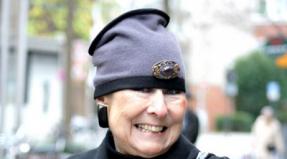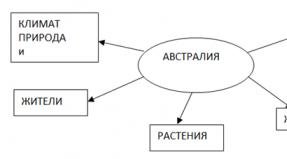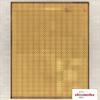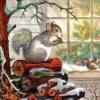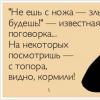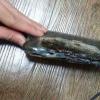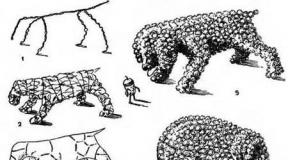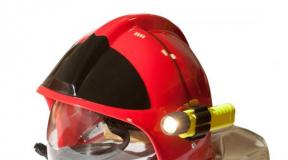Child draws the sun psychology. Assessment of the level of development
Children's drawings are a real storehouse of information. They reveal feelings, fears and even the character of the artist. Look closely at a child's drawing and you will see how he perceives the world.
What does a child's drawing mean?
In order to correctly interpret, parents should in no case criticize the work. Pink leaves on the tree, lack of hair or eyes on the characters - do not point out such "flaws", otherwise you will deprive yourself of useful information. What should be done is to ask why the characters are sad or funny, who is the most beautiful, less pleasant. When studying children's drawing, remember that it does not give a complete decoding of true feelings and thoughts. If the finished image is too gloomy, visit a specialist. The psychologist will read the artist's messages, talk to him and give instructions on how to meet the needs of the baby.

Deciphering a children's drawing my family
The interpretation of the drawing my family is possible without the help of a psychologist, if you know all the nuances. The easiest way to learn more about a child is to look at a family drawing.
2. Attachment. The closest relatives to the baby show deep emotional attachment, this also applies to the case when the child in the picture holds someone's hand.

3. Lack of hands. If parents are drawn with hands and brothers without hands, this shows a strong attachment to parents and problems in communicating with brothers or sisters. What could be the conflict? For example, in the use of toys. The artist depicts a brother without hands so that he does not take anything.
4. Safety. Is there an object placed between the child and the parent—a tree or an animal? This means that the baby does not feel safe next to the person "on the other side." Perhaps the separated adult is too hard or demanding.
5. Dislike. People who cause anxiety or other unpleasant feelings are in the corner of the sheet or separate from other family members. Some children portray brothers this way because they get more attention or the artist is the youngest in the family and receives a lot of negativity from older brothers. An unpleasant person may not be on the sheet at all. A sign of anxiety is also the absence of all family members, with the exception of a person who deserves respect.

6. Role in the family. People who do not occupy a special role in life are portrayed as the latest. When a child draws himself last, or worse, does not enter the drawing at all, this means that he feels emotionally rejected and deprived of love.
7. The character of the child according to the drawing. The work of a small artist will tell about the character. Lines drawn with great pressure speak of confidence and vigor. Shy children draw in thin lines with less pressure, and the images are so small that there is a lot of space on the sheet. Chaotic, quick strokes characterize a very active child.

8. Aggression. The child expresses himself as an aggressive person if his "double" in the picture is holding a weapon or sharp objects.
9. Colors of children's drawing. Cheerful and very active children most often choose bright warm colors: red, yellow, orange. Calm kids add shades of green, blue, purple. Drawings with a predominance of dark brown or black indicate a bad mood and a lack of a sense of security. A sparsely colored figure indicates a bad relationship with this person. A bright, colorful figure indicates admiration. The brighter the person, the more he is loved.
10. Facial expression. If in the children's drawing everyone is smiling and at the same time, there are no negative signs, you can be sure that the child feels good. Sad or stern faces indicate unpleasant emotions caused by the situation in the family. A person who has no face reveals a desire not to have contact with him, perhaps an alcoholic father or an overly strict aunt.
If you think that the child's drawing conveys excessive aggression and the colors are too dark or gray, pay attention to the behavior of the young artist. Shyness reflects self-doubt, aggressiveness is the cause of a lack of attention, “eternal discontent” is a sign of fatigue from everyday life, a lack of vivid emotions. The best way to learn more and correct the situation is to show the image to a psychologist who, after talking with all family members, will help restore the tender child's soul.
Sometimes it happens that parents, having received a psychologist's report in kindergarten, fall into bewilderment: anxiety, aggression, rejection ... and this is all from cute children's scribbles? "All psychologists are charlatans!" - parents decide, and do not pay attention to their conclusions.
Let's find out what exactly psychologists see in children's drawings?
What age children can analyze drawings
Up to three years young painters are at the stage of "cephalopods" - they paint "bubble" people with protruding lines, symbolizing arms and legs. Drawing details is not yet available to them, moreover, often a “masterpiece” is born first, and only then its proud author begins to reflect on what exactly he depicted.
Starting from 3.5-4 years children first plan a drawing (his idea appears) and only then proceed to execution. By the age of four, the child is already quite good at using a pencil, and the “cephalopods” evolve into “cucumber people” - two ovals with stick limbs.
Five years the artist was already skilled enough to draw large details (arms, legs, eyes, mouth), and by the age of six, smaller details appeared in the drawings: nose, fingers. Often children draw in the manner of Picasso - the character's head in profile, but with two eyes.
Finally, by the age of seven the drawn people are dressed, and in accordance with gender and age, they have hats and hairstyles and even necks!
” Drawings of children from 4 to 7 years old are best suited for analyzing their psychological state.
Analyzing the family drawing
The most popular theme is the drawing of one's own family. He can tell a lot to an experienced psychologist, but ordinary mothers and fathers can also learn a lot of useful information from the picture. First of all, look for warning signs.
The location of the figures in the figure
The arrangement of family members in the picture very accurately indicates their relationship. Often children "remove" an unwanted character from their work, explaining that "dad is at work" and the sister is "in the next room." This does not mean that the relationship is completely destroyed, often a brother or sister goes to the drawing “to another room” after a heated quarrel.
Conversely, beloved relatives may appear in the picture even if they live far away, as is often the case with grandparents.

The child depicts the closest and most beloved relative next to him. If one of the characters is separated from the others, then, most likely, the child mentally excludes him from the family circle. This may be a working dad, a brother or sister who is much older in age.
” A bad sign - if this "outcast" turns out to be the child himself, this is a really alarming situation!
Image of yourself
The child, as a rule, depicts himself either in the center of the picture (this is a common situation for a family with an only child), or next to the central figure. By depicting himself on the edge of the composition, apart from his parents, the child shows that he feels his isolation from his relatives. Sometimes he gives a plot explanation for this, which confirms the fears of the observer: "Everyone is celebrating, and I am punished (must sleep, read, play alone)."
The posture of a happy and self-confident child is as open as possible: the arms and legs are “spread out”. If a child takes the trouble to draw himself with his hands pressed to his body, this symbolizes his self-doubt. Too short arms or their absence - fears of one's own ineptitude. Maybe you criticize your baby too often?

Usually the child depicts the sizes of the figures in proportion to the real characters: the parents are bigger, himself - smaller, younger brother and sister - very small. The downplaying of the painted self speaks of insecurity, the need for care and, perhaps, fear.

Another situation that speaks of uncertainty is the child’s “tearing off the ground”, when all the characters are drawn in the correct proportions, but the child, as it were, hangs between the parents: his head is on the same level as the adult, and his legs do not reach the floor. Often the parents of such a small artist do not even realize that he is experiencing discomfort: after all, they communicate with him on an equal footing!

Fear and aggression in children's drawings
Psychologists are aware of the signs of fear and aggression in children's drawings, which are often invisible to parents.
Large, simply huge rake hands appear in that family member who is distinguished by aggressive behavior. If a child portrays himself as such, then he probably constantly has to suppress anger in himself.
Clearly traced bright pupils are a sign of a child's anxiety, as well as hard shading with pressure.

Finally, hypertrophied fists, teeth, sharp nails are the clearest evidence of aggression. If a child draws himself like this, then most likely he feels a constant need for protection that the family cannot provide him.
Sex and children's drawings
Contrary to popular fears, the depiction of the genitals in the drawings of 3-4-year-old children does not at all indicate that someone is corrupting the baby, but rather about his interest in his own body and about the difference between the sexes, which he just learned about.
But if a child of 6-7 years old portrays himself with the physiological attributes of an adult: a girl with a clearly defined bust, a boy with a beard and mustache - this can alert. However, most often such drawings testify to the child's need for attention, the desire to embellish himself by any means. That is why children, depicting a family, pay special attention to their figure: they carefully draw clothes, accessories, jewelry (babies often draw crowns for themselves). This picture screams: “Hey, everyone, finally look at me! I'm a prince (princess)!"
However, you should still once again pay attention to the environment of the child. Is it certain that no one is showing suspicious attention to him, has the child got access to information that is inappropriate for his age (for example, a porn movie, a porn magazine) that can scare him?
Children's drawing and color
The child's drawing is usually multi-colored and colorful - usually children use 5-6 colors, this is considered the norm. The more confident the child feels, the brighter the colors they use. Of course, not everything is so simple: a child can shade dad in black, because dad really has a favorite sweater of that color, but if some pencil is among the favorites and one or two colors clearly predominate in the picture, then you should pay attention to this factor.
Most specialists rely on the interpretation of colors by Max Lüscher, a psychologist and color researcher. He came to the conclusion that the choice of color reflects the psychological state of a person and even indicates his bodily health.
Here's how you can determine the meaning of color in a child's drawing.
dark blue- focus on internal problems, the need for peace;
green- balance, independence, perseverance, striving for security;
Red- willpower, aggression, increased activity, excitability;
yellow- positive emotions, spontaneity, curiosity, optimism;
purple- fantasy, intuition, emotional and intellectual immaturity (children often prefer this color);
Brown- sensual support of sensations, slowness, physical discomfort, often - negative emotions;
the black- depression, protest, destruction, urgent need for change;
if the child prefers a simple pencil and does not color the drawing- indifference, detachment, desire to close.

When experimenting with an independent analysis of a child's drawing, try to have the child complete it with desire, in a calm environment, without being distracted.
Pay attention to the following factors.
Composition drawing. Whether the characters were placed in the center of the picture or in the corner, was there enough space for everyone in the picture, in what order are the family members drawn.
What kind colors the child is using.
How details he pays more attention. How are the arms, legs, faces of the characters drawn, is the pressure of the pencil always the same.
What kind unusual elements is in the picture. Is there something extra (for example, the sun in the room, a non-existent pet or family members), or, on the contrary, something is missing (one of the family members).
Like a child portrays himself, what details he pays special attention to, where he sees himself in the family hierarchy.
We hope this little experiment will help you reach an understanding with your child!
Children's drawings for illustration are taken from free sources
Drawing for a child is not art, but speech. Drawing makes it possible to express what, due to age restrictions, he cannot express in words. In the process of drawing, the rational fades into the background, prohibitions and restrictions recede. At this moment, the child is absolutely free. Children's drawing most often clearly demonstrates the sphere of interests of the smallest artist. In the early stages of development (up to three years) - these are dashes, lines, circles. The kid "tryes" a pencil or a brush, experiments. Usually he first makes a drawing, and then comes up with what he depicted, on what this it might look like. Later (by the age of four) appears drawing idea . From a certain age (at 3.5 - 4 years), a person becomes the object of close attention and study. From the point of view of psychodiagnostics, a drawing of a person is one of the most accurate and reliable sources of information. The difficulty lies only in the fact that the information contained in such a message is, figuratively speaking, “encoded”, and the drawing must be correctly “read”. Psychologists who use drawing techniques in their work must have sufficient qualifications and experience working with children. However, attentive parents can always notice something unusual in the child's creative work, feel his mood, catch the hidden tension. Therefore, as a "first aid" we offer several lessons in the analysis of children's drawings.
Details of children's drawing depend on age
The child should be asked to draw his family. Moreover, so that everyone was busy with some business. Let him have a choice of colored pencils and enough paper - a regular landscape sheet (A4 format) is fine. Do not rush the baby or comment on his drawing in the process of drawing. And when he finishes the family portrait, it's time to ask questions: who exactly did he draw and what are all these characters doing. When starting to analyze a drawing, adults should take into account that its content and, relatively speaking, quality depend on the age of the young artist. In three-year-old children, people most often look like "cephalopods": some creatures whose body and head are a single "bubble" with legs. A face may also appear. But, strictly speaking, it will be more correct to analyze the drawing from the point of view of personal development and psycho-emotional state from 4-5 years . By the age of four, a child usually already depicts a person in the form of two ovals with arms and legs - sticks. The head, eyes, torso, arms, legs appear in the drawings of five-year-old children. At six years old, the nose, mouth, fingers are added to the above (their number is insignificant). By the age of seven, “painters” no longer lose sight of such details of the human image as the neck, hair (or hat), clothing (at least in a schematic form), and arms and legs are depicted in double lines. Usually, these criteria are guided by the assessment of the mental development of the child.
Analysis of a child's drawing according to ... own feelings
Home hierarchy
Particular attention is paid to the analysis of the structure of the family pattern. It is necessary to compare its real composition with that which is depicted by the child on paper. You should also evaluate the drawing order, the size of the shapes, and their placement on the sheet. The first and largest, as a rule, depicts the most significant member of the family in the understanding of the young artist. Children usually draw themselves next to those to whom they feel the greatest affection. And farthest in the figure is the most unsympathetic relative to the baby. The image in profile or with the back also indicates a tense relationship between this family member and the author of the drawing. Children live in the moment. And often emotional relationships with someone close (a recent quarrel, resentment) can make their own adjustments to the drawing. In this case, the baby may even “forget” someone. For example, 6-year-old Alyosha does not draw his father, who pays him little attention and is rude. And he explains his absence in the figure by the fact that "dad went on a business trip." Alice (4 years old) did not draw her little sister Ksyusha, explaining her absence by the fact that the baby is “sleeping in another room”. The girl cannot come to terms with the fact that her mother, because of her sister, does not give her as much attention as before. There are also reverse situations, when the child depicts in the picture really non-existent family members. Sasha (5 years old) surprised his mother a lot when he drew a playing baby next to him and announced that he finally had a brother! Such “adjustments” to the composition of the family are made by children who are dissatisfied with their emotional situation. They need more benevolent attention from adults and games "on an equal footing", or better - entertainment in the company of other kids of the same kind. An important role in the analysis of children's drawings is played by what family members are doing. If they are united by some common cause, most often this indicates a favorable family climate. very meaningful an indicator of psychological proximity is the real distance between the depicted figures . By drawing himself apart from the rest, the child can “signal” his isolation in the family. If he separates his relatives from each other with partitions or places them in different "rooms", this may indicate problems in communication. The size of the image indicates what place this person occupies in the emotional life of the family. For example, if a child draws a younger brother or sister larger than himself, then we can assume exceptional attention to him from relatives. He "takes up a lot of space in their lives." The absence of the smallest artist in the drawing is a frequent sign that the child feels lonely in the family, and there is “no place” for him in relationships between loved ones. You can check this by asking the kid the question: “Maybe you forgot to draw someone?” It happens that even a direct indication: “you forgot to portray yourself” the child ignores or explains: “there is no space left”, “then I will finish it”. This situation is a serious reason to think about family relationships. A very dense image of figures, as if overlapping each other, speaks of an equally close relationship between people close to the baby or his need for such connections.
Evaluation of "manner of writing"
A fairly common sign of increased anxiety in a child is self-correction. Especially those that do not improve image quality. There are drawings from individual small strokes - the baby seems to be afraid to draw a decisive line. Sometimes the whole drawing or some of its parts is hatched. In such cases, one can also assume the increased anxiety of the young artist. It is worth paying attention to the exaggeratedly large eyes in the portrait, especially if the pupils are densely shaded in them. Perhaps the baby is experiencing a feeling of fear. numerous decorations, the presence of additional details and elements of the costume by the author of the drawing indicate the demonstrativeness of the child, his desire to be noticed, craving for external effects. This is more common in girls. Very weak pencil pressure, low (not for age) detail pattern occurs in asthenic children, prone to rapid fatigue, emotionally sensitive, psychologically unstable. And children who easily, for no apparent reason, change their mood, usually in the process of drawing they often change pressure: some lines are barely noticeable, others are drawn with noticeable effort. give the impression of careless, uncontrolled. Here, strong pressure and gross violations of symmetry attract attention. Sometimes the drawing "does not fit" on the sheet. There are drawings where everyone figures are depicted very small. Usually the entire composition is oriented towards some edge of the sheet. This means that the baby feels weak and does not believe in his own strength. Perhaps one of the relatives is very strict with him or the requirements for the child do not correspond to his real capabilities. If baby portrays himself in an open pose (arms and legs are widely spaced, the figure is large, often rounded), this indicates his sociability and cheerfulness. On the contrary, a “closed” posture (hands pressed to the body or hidden behind the back, the figure is elongated, angular) rather indicates a closed person, inclined to restrain his feelings and thoughts. Both in the drawings of boys and in the drawings of girls one can often notice symbols of aggressive tendencies behaviors: large accented fists, weapons, intimidating posture, clearly traced nails and teeth. Despite seeming hostility, they can be an expression of a protective form of behavior. . Adults should figure out what is a source of increased emotional danger for their child, and why he needed such a demonstration of his strength. A special place is occupied drawings in violation of accepted image standards . In particular, the image of the genitals. For young children (up to 4 years old), this is rather a frequent occurrence. This reflects the tendency towards the naturalness of life in all its manifestations. In older preschoolers, such a drawing speaks of demonstrativeness, the desire to attract attention in a provocative way, and serves as an expression of aggression.
Is the palette a mirror of the soul?
Children very early begin to "feel" the color and select it according to their mood and attitude. Dr. Max Lüscher, a psychologist and color researcher, has studied the selection of shades from the color range by different people. He came to the conclusion that the choice of color reflects the psychological qualities of a person and his state of health. Number of colors used by the child can be viewed from several perspectives. First of all, it is a characteristic of the level of development of the emotional sphere as a whole. Usually children use 5-6 colors. In this case, we can talk about the normal average level of emotional development. A wider palette of colors suggests a sensitive nature, rich in emotions. If a child over 3-4 years old draws with 1-2 colored pencils, this most likely indicates his negative state at the moment: anxiety (blue), aggression (red), depression (black). The use of only a simple pencil (if there is a choice) is sometimes interpreted as the "lack" of color, so the child "reports" that his life lacks bright colors, positive emotions. The most emotionally significant figures are distinguished by a large number of colors. And openly not accepted characters are usually painted in black or dark brown. Colors can also convey certain character properties and state. Each color has its own symbolic meaning. :
- dark blue - concentration, focus on internal problems, the need for peace and satisfaction, introspection;
- green - balance, independence, perseverance, stubbornness, striving for security;
- Red - willpower, eccentricity, outward orientation, aggression, increased activity, excitability;
- yellow – positive emotions, spontaneity, curiosity, optimism;
- purple - fantasy, intuition, emotional and intellectual immaturity (children often prefer this color);
- Brown - sensual support of sensations, slowness, physical discomfort, often - negative emotions;
- the black - depression, protest, destruction, an urgent need for change;
- Gray - "absence" of color, indifference, detachment, desire to leave, not to notice what disturbs.
From theory to practice
So, the kid spent several minutes over a sheet of paper with pencils in his hands, and the picture is ready. How much that is important for him and for his parents is hidden in this picture! Let's try to read it? Here the child has portrayed himself, but the pose is unstable, and there is no face. How do you communicate without a face? - Difficult! Here is the baby in the crib - lay down to rest. Perhaps he is tired. Or maybe sick? And I chose brown. Yes, that's right - the temperature! Why do all the girls draw princesses? That's how they feel or...really want it. Just to be in the spotlight, to be the very best ... And what is the demand from the princess? Here is a boy armed to the teeth. He needs protection. Maybe someone offended him.
Examples of analysis of specific drawings:
Children's drawing 1
The author of this “family portrait” is Alyosha (6 years old).
Age criterion The behavior of the child contains features inherent in an earlier age, the emotional-volitional sphere is characterized by immaturity. All the characters in the picture are depicted in the same way. Clothing, with its inherent details, is missing. The hairstyle is a symbolic sign of gender. The characteristic absence of a neck in the depicted people in this case indicates the difficulty of controlling the mind over bodily impulses, that is, Alyosha's behavior shows high mobility, at times - disinhibition, impulsivity. Emotional characteristic The drawing is bright, light, cheerful, orderly, rather benevolent. Features of the family image The family in the figure is reflected in its entirety. In the center of the composition is the father as an important subject in the domestic hierarchy. It can be assumed with sufficient certainty that the mother is physically and emotionally closer to Alyosha. The resulting couples are noteworthy: mother - son (the youngest in the family), father - daughter. Sister Lena is farthest from the author of the drawing. Probably not everything is going well in their relationship. It is significant that of all family members, only dad "stands firmly on the ground." The rest - soar, a little "hovering in the clouds." In general, we can talk about fairly warm and close relations between family members. This is evidenced by the slight distance between them, the choice of a common color and the image in the same range of a house with smoke from a chimney, symbolizing the “warmth of a family hearth”. "Writing Style" All lines of the drawing are made with confident, decisive movements. It is probably this style of behavior that is most characteristic of Alyosha. But the strong pressure and accentuated shading of the boy’s body speak of inner restlessness, anxiety, perhaps physical (literally bodily) malaise. The hairstyle gives out an active nature, at times, perhaps aggressive. An interesting detail is the peculiar antennas (according to Alyosha), which in the figure "grow" from the boy's ears. They symbolize the need for information in order to compensate for difficulties in communication (the child in the image does not have a face). The poses of all the characters are open, the figures are rounded, which suggests cheerful, sociable people. In the case of Alyosha, this seeming contradiction can mean: “I want to communicate, play, but they don’t always understand me.” Palette The color scheme of the picture is very symbolic. The little artist opted for a signal red color for all family members, especially for himself. This indicates an outward orientation, sociability, increased activity of the author of the drawing. Additional green emphasizes the desire for independence and the desire to insist on one's own as a habitual way of behavior. An important detail of the picture is a clearly traced surface of the earth. If Alyosha spent a lot of time on her image, this is probably something important for him. In this case, you can consider the earth as a need for support, greater stability and stability. The purpose of drawing analysis is always a deeper understanding of the child, looking at the family through his eyes and identifying ways to positive changes. In this case, I would like to recommend to Alyosha's parents that they pay more attention to deep, confidential communication with their son, talk to him more often just like that, and ask him for his opinion on various issues. They should also consider what is the difficulty of contact between son and daughter. And outdoor activities, games in the air can significantly reduce emotional and physical stress.
Children's drawing 2.
Its author is Maxim (4 years 10 months)
 Age criterion
This pattern is more typical for six-year-old children. We can say that the boy develops intellectually ahead of his age. Emotional characteristic
The drawing is bright, dynamic, but restless. Features of the image of the family.
The family is shown in its entirety. Attention is drawn to the sexual identification of the young author with his father (see clothes). However, emotionally the child is still closer to the mother, which is typical for a preschooler. It is interesting that the boy does not seem to have enough space in the drawing, he is unsteady on his feet. His position is unstable and changeable. Palette
The child chose purple for himself, which, combined with his insecure position in the family (this was mentioned above), indicates possible psycho-emotional instability, frequent mood swings. For mom, the little artist chose an energetic, somewhat chaotic, yellow color. Dad is brown. In his image, attention is concentrated on the physical body. This is how a child sees his parents. "Writing Style"
The figures are large, angular - most likely, in the communication of the child there is some straightforwardness and a tendency to conflicts (sharp corners). Noticeable shading and clearly traced pupils suggest the presence of hidden anxiety.
Age criterion
This pattern is more typical for six-year-old children. We can say that the boy develops intellectually ahead of his age. Emotional characteristic
The drawing is bright, dynamic, but restless. Features of the image of the family.
The family is shown in its entirety. Attention is drawn to the sexual identification of the young author with his father (see clothes). However, emotionally the child is still closer to the mother, which is typical for a preschooler. It is interesting that the boy does not seem to have enough space in the drawing, he is unsteady on his feet. His position is unstable and changeable. Palette
The child chose purple for himself, which, combined with his insecure position in the family (this was mentioned above), indicates possible psycho-emotional instability, frequent mood swings. For mom, the little artist chose an energetic, somewhat chaotic, yellow color. Dad is brown. In his image, attention is concentrated on the physical body. This is how a child sees his parents. "Writing Style"
The figures are large, angular - most likely, in the communication of the child there is some straightforwardness and a tendency to conflicts (sharp corners). Noticeable shading and clearly traced pupils suggest the presence of hidden anxiety.
Children's drawing 3
Petya, 6 years old.
 The drawing is bright, saturated, energetic, well organized. It is consistent with the age of the artist. In the structure of the family, there are "adult" and "children's" groups. The younger brother and sister strive emotionally and physically to be closer to Petya. Probably in the family psychologically close, equal relations. Mom is the most vivid, emotional image. The child highlights the image of the mother with the help of color and draws it first. Petya portrays himself as an adult. The arms are somewhat shortened compared to other images. This is usually found in the drawings of children who consider themselves insufficiently skilled, critical of their practical skills and capabilities. The sun and flowers are very common in children's drawings. It is worth paying attention if their appearance is unjustified by the situation. For example, the sun appears in a drawing of a room. Then we talk about the need for warmer relationships in the family. In Petya's drawing, these symbols most likely indicate a positive attitude towards his family.
The drawing is bright, saturated, energetic, well organized. It is consistent with the age of the artist. In the structure of the family, there are "adult" and "children's" groups. The younger brother and sister strive emotionally and physically to be closer to Petya. Probably in the family psychologically close, equal relations. Mom is the most vivid, emotional image. The child highlights the image of the mother with the help of color and draws it first. Petya portrays himself as an adult. The arms are somewhat shortened compared to other images. This is usually found in the drawings of children who consider themselves insufficiently skilled, critical of their practical skills and capabilities. The sun and flowers are very common in children's drawings. It is worth paying attention if their appearance is unjustified by the situation. For example, the sun appears in a drawing of a room. Then we talk about the need for warmer relationships in the family. In Petya's drawing, these symbols most likely indicate a positive attitude towards his family.
Children's drawing 4
Polina, 7 years old.
 Often children draw arbitrarily, without a special task, asking: "I draw a girl like me." In this case, we observe a somewhat idealized representation of the child about himself. Let's pay attention to the picture of Pauline. It is located at the top of the sheet, quite large and bright. We can talk about the positive self-esteem of the child, activity, emotionality. Probably, the girl is distinguished by high self-control, developed intelligence, and sociability. But she lacks stability (pay attention to the accentuated line of the earth and the small legs of the child). From a psychological point of view, it is about self-doubt. This usually happens in a family where one child is brought up: he is given, paradoxically as it sounds, too much attention, they control and direct every step. Thus, the child is deprived of the opportunity to somehow show independence. Gradually getting used to this situation, the child is afraid to take the wrong step and waits for "valuable instructions." Maybe Polina should sometimes make her own mistakes and learn from them?
Often children draw arbitrarily, without a special task, asking: "I draw a girl like me." In this case, we observe a somewhat idealized representation of the child about himself. Let's pay attention to the picture of Pauline. It is located at the top of the sheet, quite large and bright. We can talk about the positive self-esteem of the child, activity, emotionality. Probably, the girl is distinguished by high self-control, developed intelligence, and sociability. But she lacks stability (pay attention to the accentuated line of the earth and the small legs of the child). From a psychological point of view, it is about self-doubt. This usually happens in a family where one child is brought up: he is given, paradoxically as it sounds, too much attention, they control and direct every step. Thus, the child is deprived of the opportunity to somehow show independence. Gradually getting used to this situation, the child is afraid to take the wrong step and waits for "valuable instructions." Maybe Polina should sometimes make her own mistakes and learn from them?
Children's drawing 5
Alexandra, 4 years old.
 The drawing is dynamic, bright, somewhat chaotic. The emotional center of the family, of course, is the mother: heat (the sun), the child, the dog are concentrated around her. Her dress is decorated with a pattern. Please note that Sasha draws herself as an equal with adults and only her legs do not reach the ground. The character of the girl is probably fighting, impulsive, boyish. The lines of the drawing are sweeping, with strong pressure suggest a low level of self-control. For such children, games with simple rules that involve several players are useful. Active sports will also teach you to better understand yourself and correlate your desires with the interests of the team.
The drawing is dynamic, bright, somewhat chaotic. The emotional center of the family, of course, is the mother: heat (the sun), the child, the dog are concentrated around her. Her dress is decorated with a pattern. Please note that Sasha draws herself as an equal with adults and only her legs do not reach the ground. The character of the girl is probably fighting, impulsive, boyish. The lines of the drawing are sweeping, with strong pressure suggest a low level of self-control. For such children, games with simple rules that involve several players are useful. Active sports will also teach you to better understand yourself and correlate your desires with the interests of the team.
Children's drawing 6
Petya, 4 years 6 months
 A completely unusual drawing for a child of 4.5 years. The cephalopods immediately turned into mature drawings. This is especially true for images of adults. Undoubtedly, this is a drawing of a very observant, developed and at the same time anxious child. Abundant shading, density, tightness of the image, emphasized traced eyes indicate the presence of anxiety. The most striking, significant figure is the pope. Pay attention to how the shading of clothing varies among family members. Dad's - in a strictly defined direction, the suit is official. Probably in life, dad is a very organized, businesslike person. The figures in the figure are depicted very tightly. This may indicate an equally close relationship in reality. But our protagonist seems to need more physical and psychological space for an active life. At first glance, it may seem that the analysis of children's drawings is not such a difficult task. However, I would like to warn parents against harsh formulations and making a psychological diagnosis. Indeed, behind the seeming simplicity and elegance of the method, there are many nuances, interrelations of individual manifestations and features. In addition, a person analyzing a drawing considers it through the prism of his personal experience and state at a given moment in time. Therefore, you should not draw far-reaching conclusions on your own. And if something in the child's drawing alerted or puzzled the parents, it is better not to postpone the visit to the specialist. Let us help you figure it out!
A completely unusual drawing for a child of 4.5 years. The cephalopods immediately turned into mature drawings. This is especially true for images of adults. Undoubtedly, this is a drawing of a very observant, developed and at the same time anxious child. Abundant shading, density, tightness of the image, emphasized traced eyes indicate the presence of anxiety. The most striking, significant figure is the pope. Pay attention to how the shading of clothing varies among family members. Dad's - in a strictly defined direction, the suit is official. Probably in life, dad is a very organized, businesslike person. The figures in the figure are depicted very tightly. This may indicate an equally close relationship in reality. But our protagonist seems to need more physical and psychological space for an active life. At first glance, it may seem that the analysis of children's drawings is not such a difficult task. However, I would like to warn parents against harsh formulations and making a psychological diagnosis. Indeed, behind the seeming simplicity and elegance of the method, there are many nuances, interrelations of individual manifestations and features. In addition, a person analyzing a drawing considers it through the prism of his personal experience and state at a given moment in time. Therefore, you should not draw far-reaching conclusions on your own. And if something in the child's drawing alerted or puzzled the parents, it is better not to postpone the visit to the specialist. Let us help you figure it out!
The smallest "artists" (up to 3 years old) draw seemingly meaningless lines and circles on a piece of paper.
A little later (by 4-5 years) the idea of a drawing appears - mom, dad, animals, house. How he draws a person, what colors he uses - all this can give the psychologist enough information to interpret the child's drawing.
A specialist, using children's psychological tests based on drawings, can feel the mood of the baby, identify the cause of fears, catch hidden tension and even serious problems of mental development. Parents who do not have professional skills in the psychology of children's drawing can also get an idea of the state of mind of the crumbs. To do this, it is enough to ask the child to draw a family, providing him with pencils or felt-tip pens of all possible colors.
Psychology of creativity: what children's drawings say
Interpretation of a drawing by color
Take a look at the child's creation and try to guess what the child's drawing says by the main color. Psychology interprets colors as follows.
- The predominance of pastel shades in the drawing(blue, pink, lilac) speaks of harmony and freedom of the individual. "Pink" babies are important tactile sensations, hug them more often, kiss.
- The predominance of red indicates the openness and activity of the child. As a rule, such a baby is excitable, restless and often naughty. However, there is nothing to worry about, because this is only his individual feature. These kids are full of energy. As they mature, they will be able to succeed in life.
- If the child's drawing is done in blue, in psychology, this is a sign of balance. Such children are more calm and unhurried.
- Green- the color of stubbornness and perseverance. Light green indicates the need for protection. Dark green should alert parents - the child lacks attention and love. Such children grow up closed, therefore, from a very young age, they need to be brought up with openness and instill confidence in security.
- According to the psychology of children's drawing, yellow- the color of a dreamy baby with a vivid imagination and a well-developed imagination. Such kids love to play alone, while using abstract toys (various twigs, pebbles, etc.).
- If a child draws orange sky, orange mom- this is a sign of excitement that has no way out. These babies are difficult to calm down, so it is better to direct their energy to help their parents around the house. It is very good if among these cases there is one that will arouse interest in the child.
- Prevalence purple is an indicator of high sensitivity. This is a creative person with a rich inner world. These are vulnerable children who need affection and encouragement more than others.
The predominance of dark shades in the children's drawing should definitely cause concern. In this regard, psychology says the following.
- Brown: negative emotions, health problems, experiencing family troubles.
- Gray: poverty, rejection, isolation.
- Black: stress, threat, and even psychological trauma.
- Dark red (burgundy with shades of black): depression, anxiety.
The predominance of these colors indicates problems with which it is better to immediately contact a psychologist.
Press on the pencil
Weak pressure speaks of timidity and passivity. If the baby constantly erases the lines with an elastic band, this is a sign of insecurity and anxiety. Strong pressure is evidence of emotional tension. And if the pressure is so strong that the paper is torn, this indicates conflict and.
Pattern position and size
The image at the top of the sheet is a sign of high self-esteem or daydreaming. The location of a small picture at the bottom of the page - emotional distress, low self-esteem, depression.
If the drawing turned out to be so large that the baby glued another sheet to it in order to complete the missing one, this is an indicator of an alarming state. Also, such drawings are often drawn by hyperactive children.
At the end of the article, we have prepared for you a checklist "Creative clutter in the apartment, how to control it!" Download it and you will not be afraid of children's creative experiments!
Analysis of children's drawing
The interpretation of a person's drawing in psychology is done by art therapists, psychologists, and social workers. When interpreting a children's drawing, it is important to take into account the age of the baby. People at three-year-olds turn out to be "cephalopods", this is normal. However, it is still better to judge the psychology of children's drawing from the point of view of the psycho-emotional state of the "artist" when the baby is 4, 5 or 6 years old.
Joyless faces in the picture or their absence, threatening facial expressions and gestures- may indicate the emotional distress of the child. However, experts reassure: it is not worth judging by one picture. It is a completely different matter when all the drawings of a child, created on different days and months, have a similar tendency to gloominess.
Analyzing a children's drawing, you should pay attention to its structure by comparing the real composition of the family with that depicted on paper. For example, the girl Olya did not draw her little sister among other family members. There is jealousy towards the younger sister, a feeling of lack of attention. The same is said if Olya draws her sister larger than herself.
If the baby has not portrayed himself, this is a sign of loneliness and a serious reason to think about family relationships.
Also notice in what order the child draws people. The character drawn first is the main one for the child. A family member, depicted sideways or back, in a tense relationship with the author of the drawing or in a quarrel with him.
During the psychological decoding of children's drawings, look at what the family members depicted on it are doing. When they are doing something together, drawn close to each other, all this is a sign of family well-being. But the fragmentation of the characters speaks of discord in the family.
Children's psychological tests according to drawings
In their work, specialists often use children's psychological tests based on drawings for children, in which they ask the child to draw a family, the same girl, the same boy, or other situations. According to the drawing, the psycho-emotional state and personal development of the crumbs are assessed. Let's look at examples.

Psychological analysis of children's drawing with an example.
Download the checklist "Creative clutter" in the apartment, how to control it!
What is a "creative mess" - any mother knows, it is useless to fight it. How to help your child develop and at the same time spend less time cleaning? Follow the tips from the checklist and you will not be afraid of children's creative experiments!
As you know, with the help of a drawing, you can determine the level of development of the child and the characteristics of his psyche. Drawing a baby gives an idea of mental development. Personal qualities are interpreted through drawing, starting from the senior preschool age. Often, for this purpose, a drawing of a person is used - that which is most interesting for children to depict, and with which it is easiest for them to associate themselves.
Parents can also do this test. Although a person who does not have special knowledge on this topic will not be able to make a diagnosis and draw deep conclusions, the main features are not difficult to determine. If you know where to look.
For the test, give your child a blank piece of paper, preferably A4, and lay it upright. You need to draw with medium soft pencils. It is good if the child also has an eraser at hand. But then keep a close eye on what he erases and what he draws in return. The task of the child is to draw a person. And he must do this carefully and beautifully, as far as he has enough skill.
When the drawing is ready, praise the child, clarify the details that you do not understand, and proceed with the interpretation. Every little thing matters here.
Head
This is the realm of the intellect, imagination, and the control of desires and urges.
If a child pays little attention to his head, this may indicate problems of social adaptation, communication difficulties, weak intellectual abilities, or even the presence of neurosis.
If the head is depicted last, there is a suspicion that there are some interpersonal conflicts.
- disproportionately large head - confidence that thinking means a lot in a person's life; in the opposite sex - recognition of the superiority of the opposite sex; may indicate headaches;
- small head - the child considers himself intellectually backward from the environment;
- indistinctly drawn head - shyness, timidity.
- clearly drawn - aggressiveness, which can be protective.
It is considered by many psychologists as a sexual symbol. But in the case of a child's drawing, this interpretation is more than debatable.
- wide, prominent - contempt;
- the absence of a nose is a certain degree of intellectual insufficiency, immaturity.
